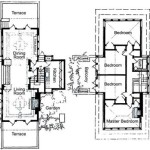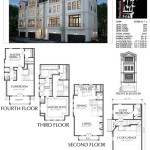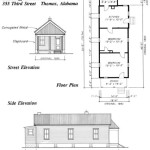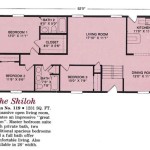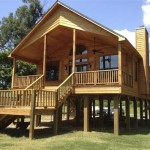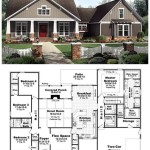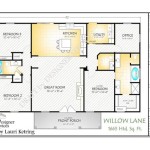Small modern house plans are architectural designs that prioritize compact living spaces while incorporating contemporary design principles. These plans cater to individuals or families seeking a minimalist lifestyle, reduced environmental impact, or affordability. By utilizing space-saving techniques, modern materials, and efficient layouts, small modern house plans maximize comfort and functionality within limited square footage.
A prevalent example of a small modern house plan is the “tiny house” movement, which advocates for simplified living in dwellings typically under 400 square feet. Tiny houses often feature multi-functional spaces, innovative storage solutions, and energy-efficient appliances to create a cozy and sustainable environment.
Whether it’s for downsizing, environmental consciousness, or budget constraints, small modern house plans offer a compelling alternative to traditional large homes. In this article, we will explore the key features, advantages, and considerations when designing and building a small modern house, providing insights and practical guidance for those seeking to embrace this architectural trend.
When designing a small modern house plan, several key considerations should be taken into account:
- Maximize natural light
- Prioritize open floor plans
- Incorporate multi-use spaces
- Utilize vertical space
- Choose energy-efficient materials
- Consider passive design principles
- Simplify exterior forms
- Focus on sustainable features
- Pay attention to storage solutions
By carefully addressing these aspects, small modern house plans can achieve both aesthetic appeal and practical functionality.
Maximize natural light
Incorporating ample natural light into a small modern house plan is crucial for creating a bright, airy, and inviting living space. Natural light not only reduces the need for artificial lighting, saving energy, but also improves overall well-being and mood. Here are key strategies for maximizing natural light in small modern house plans:
Large windows and glass doors: Installing large windows and glass doors allows abundant natural light to penetrate the interior spaces. Consider floor-to-ceiling windows or sliding glass doors that connect indoor and outdoor areas, blurring the boundaries between the two.
Skylights and solar tubes: Skylights and solar tubes are effective ways to bring natural light into areas that lack direct access to windows, such as hallways, bathrooms, and closets. Skylights provide overhead illumination, while solar tubes redirect sunlight into interior spaces through reflective tunnels.
Light-colored interiors: Using light-colored paints, finishes, and furnishings reflects and amplifies natural light, making spaces feel larger and brighter. Avoid dark colors that absorb light and create a gloomy atmosphere.
Strategic placement of windows: Carefully consider the placement of windows to optimize natural light distribution. Position windows on multiple walls to allow light to enter from different angles and create a more balanced and diffused illumination.
By incorporating these strategies, small modern house plans can harness the power of natural light to create a comfortable, energy-efficient, and visually appealing living environment.
Prioritize open floor plans
Open floor plans are a defining characteristic of small modern house plans, maximizing space utilization and creating a sense of spaciousness within limited square footage. By eliminating unnecessary walls and partitions, open floor plans allow for seamless transitions between different functional areas, promoting a more fluid and connected living experience.
One of the key advantages of open floor plans in small modern house plans is their ability to enhance natural light distribution. By removing physical barriers, light can penetrate deeper into the interior spaces, creating a brighter and more welcoming atmosphere. This not only reduces the need for artificial lighting but also improves overall well-being and mood.
Open floor plans also promote a greater sense of connection and interaction among occupants. By eliminating visual and physical barriers, family members and guests can easily engage with each other, fostering a more sociable and communal living environment. This is particularly beneficial in small spaces, where traditional closed-off rooms can create a sense of isolation and confinement.
Furthermore, open floor plans offer greater flexibility in furniture arrangement and space utilization. Without the constraints of fixed walls, furniture can be easily rearranged to accommodate different needs and preferences, allowing homeowners to adapt their living space as their lifestyle evolves.
While open floor plans offer numerous benefits, it’s important to consider the potential drawbacks, such as reduced privacy and noise control. Careful space planning and the strategic placement of furniture and partitions can help mitigate these concerns while maintaining the advantages of an open floor plan.
Overall, prioritizing open floor plans in small modern house plans is a key design strategy to maximize space utilization, enhance natural light distribution, promote social interaction, and provide greater flexibility in furniture arrangement.
Incorporate multi-use spaces
Incorporating multi-use spaces is a clever design strategy in small modern house plans to maximize functionality and space utilization. By assigning multiple functions to a single space, homeowners can create flexible and adaptable living environments that cater to their evolving needs and lifestyles.
One common example of a multi-use space is the living room that doubles as a dining area. By carefully arranging furniture and incorporating space-saving solutions, such as convertible sofas and nesting tables, the living room can effortlessly transform into a dining space when needed. This eliminates the need for a separate dining room, saving valuable square footage.
Another smart multi-use space is the home office that also serves as a guest room. With the increasing popularity of remote work, many homeowners are seeking dedicated workspaces within their homes. However, in small modern house plans, allocating an entire room solely for an office may not be feasible. By incorporating a Murphy bed or a sofa bed into the home office, it can easily convert into a guest room when necessary, providing both functionality and flexibility.
Multi-use spaces can also extend to outdoor areas. For example, a small patio or deck can be designed to serve multiple purposes, such as outdoor dining, relaxation, and gardening. By incorporating built-in seating, retractable awnings, and vertical planters, homeowners can create a versatile outdoor space that maximizes functionality without compromising on style.
The key to successfully incorporating multi-use spaces in small modern house plans lies in careful planning and creative design solutions. By considering the specific needs and lifestyle of the occupants, architects and designers can create spaces that are both functional and aesthetically pleasing, maximizing the potential of every square foot.
Utilize vertical space
In small modern house plans, maximizing vertical space is crucial for creating a sense of spaciousness and accommodating all necessary functions within a limited footprint. By thinking vertically, homeowners can optimize storage, create additional living areas, and enhance the overall functionality of their homes.
- Loft bedrooms: Utilizing the vertical space above other rooms, loft bedrooms can provide a cozy and private sleeping area while freeing up valuable floor space on the main level. Accessed by a ladder or staircase, loft bedrooms are ideal for small homes with limited square footage.
- Built-in shelves and cabinets: Floor-to-ceiling shelves and cabinets make the most of vertical space, providing ample storage without taking up valuable floor area. These built-ins can be customized to accommodate specific storage needs, from books and dcor to clothing and household items.
- Vertical gardens: Not only do vertical gardens add a touch of greenery to small spaces, they also utilize vertical space to grow plants and herbs. By mounting planters on walls or creating vertical trellises, homeowners can maximize their gardening potential without sacrificing floor space.
- Mezzanine levels: Mezzanine levels are elevated platforms that create additional living space within a room’s vertical volume. They can be used for various purposes, such as a home office, guest room, or reading nook, without requiring a complete room addition.
By utilizing vertical space effectively, small modern house plans can achieve a greater sense of spaciousness, improved functionality, and a more visually interesting living environment.
Choose energy-efficient materials
Selecting energy-efficient materials is crucial for creating a sustainable and cost-effective small modern house plan. By incorporating materials with high insulation values, low thermal conductivity, and airtight construction techniques, homeowners can minimize energy consumption, reduce utility bills, and contribute to a greener environment.
- Insulated concrete forms (ICFs): ICFs are hollow blocks made of polystyrene foam that are stacked together and filled with concrete. They provide excellent insulation, reducing heat loss and gain, and contributing to a more stable indoor temperature.
- Structural insulated panels (SIPs): SIPs are prefabricated panels consisting of a foam core sandwiched between two layers of oriented strand board (OSB). They offer superior insulation and airtightness, resulting in significant energy savings.
- High-performance windows and doors: Windows and doors are major sources of heat loss in a home. Choosing energy-efficient windows and doors with double or triple glazing, low U-factors, and tight seals can significantly reduce energy consumption.
- Energy-efficient appliances: Energy-efficient appliances, such as ENERGY STAR-rated refrigerators, dishwashers, and washing machines, consume less energy, reducing utility costs and environmental impact.
By carefully selecting energy-efficient materials, small modern house plans can achieve a high level of thermal performance, ensuring comfort and energy savings for years to come.
Consider passive design principles
Passive design principles harness natural elements, such as sunlight, wind, and thermal mass, to minimize energy consumption and create a comfortable indoor environment. By incorporating these principles into small modern house plans, homeowners can significantly reduce their reliance on mechanical heating and cooling systems, resulting in lower energy bills and a more sustainable living experience.
- Orientation: The orientation of a small modern house plan plays a crucial role in passive design. Positioning the house to maximize solar exposure in winter and minimize it in summer can reduce heating and cooling needs. In the Northern Hemisphere, south-facing windows allow for passive solar heat gain during the winter months, while in the Southern Hemisphere, north-facing windows are preferred.
- Thermal mass: Thermal mass refers to the ability of materials to absorb and release heat slowly. Incorporating materials with high thermal mass, such as concrete, brick, or stone, into the design can help regulate indoor temperature. These materials absorb heat during the day and release it at night, reducing the need for additional heating or cooling.
- Natural ventilation: Natural ventilation involves using strategically placed windows, doors, and vents to promote airflow and reduce the need for mechanical ventilation. Cross-ventilation, where windows on opposite sides of a room are opened to create a draft, can effectively cool a home during hot weather. In colder climates, natural ventilation can be used to remove excess moisture and prevent indoor air quality issues.
- Daylighting: Daylighting refers to the use of natural light to illuminate interior spaces. By incorporating large windows, skylights, and solar tubes into the design, small modern house plans can maximize natural light and reduce the need for artificial lighting, leading to energy savings and improved well-being.
By carefully considering passive design principles, small modern house plans can achieve a high level of energy efficiency and indoor comfort, reducing environmental impact and creating a more sustainable and cost-effective living environment.
Simplify exterior forms
Small modern house plans prioritize simplicity and clean lines in their exterior designs. By avoiding unnecessary ornamentation and complex forms, these homes achieve a sleek and elegant aesthetic that is both timeless and cost-effective.
- Clean lines and geometric shapes: Small modern house plans often feature clean lines and geometric shapes, such as cubes, rectangles, and triangles. This simplicity creates a sense of order and harmony, while minimizing visual clutter.
- Minimal ornamentation: Unlike traditional or historical house styles, small modern house plans typically eschew elaborate ornamentation and decorative details. Instead, they rely on subtle textures, natural materials, and clean lines for visual interest.
- Flat or low-pitched roofs: Flat or low-pitched roofs are common in small modern house plans. These roofs not only contribute to the home’s sleek and contemporary aesthetic but also offer practical benefits, such as reduced material costs and improved energy efficiency.
- Integrated outdoor spaces: Small modern house plans often seamlessly integrate outdoor spaces into their designs. Patios, decks, and courtyards are incorporated into the home’s overall form, creating a cohesive and inviting living environment.
By simplifying exterior forms and embracing clean lines, small modern house plans achieve a timeless and sophisticated aesthetic that enhances the home’s functionality and visual appeal.
Focus on sustainable features
In addition to their space-saving and aesthetic appeal, small modern house plans prioritize sustainable features that reduce environmental impact and promote a healthier living environment. By incorporating sustainable practices into the design and construction of these homes, homeowners can minimize their carbon footprint and create a more eco-friendly living space.
- Energy efficiency: Small modern house plans emphasize energy efficiency to reduce energy consumption and operating costs. This is achieved through a combination of passive design principles, such as natural ventilation and daylighting, and the use of energy-efficient appliances, lighting, and building materials.
- Water conservation: Water conservation is another key aspect of sustainable small modern house plans. Low-flow fixtures, water-efficient landscaping, and rainwater harvesting systems are incorporated to minimize water usage and reduce the strain on local water resources.
- Sustainable materials: Small modern house plans often utilize sustainable building materials, such as recycled steel, bamboo, and reclaimed wood, to minimize environmental impact and promote resource conservation. These materials are durable, eco-friendly, and contribute to a healthier indoor environment.
- Indoor air quality: Indoor air quality is a priority in small modern house plans. Natural ventilation, low-VOC (volatile organic compound) paints and finishes, and air purification systems are incorporated to ensure a healthy and comfortable living space, free from harmful pollutants.
By focusing on sustainable features, small modern house plans not only reduce environmental impact but also contribute to the well-being and health of their occupants, creating a more responsible and eco-conscious living environment.
Pay attention to storage solutions
In small modern house plans, maximizing storage space is crucial for maintaining a clutter-free and organized living environment. By incorporating clever storage solutions throughout the home, homeowners can utilize every inch of space efficiently and keep their belongings neatly tucked away.
One effective storage strategy is to utilize vertical space. Installing floor-to-ceiling shelves and cabinets, as well as utilizing the space above doors and windows, can significantly increase storage capacity without taking up valuable floor area. Built-in storage units, such as recessed shelving and pull-out drawers, make use of otherwise wasted space and provide easy access to frequently used items.
Multi-purpose furniture is another smart way to maximize storage in small modern house plans. Ottomans with built-in storage compartments, coffee tables with drawers, and beds with under-bed storage provide additional space for blankets, pillows, and other belongings without compromising on style or comfort. Wall-mounted furniture, such as floating shelves and hanging desks, frees up floor space while offering ample storage and display options.
Hidden storage solutions are also valuable in small modern house plans. Utilizing the space beneath stairs for built-in drawers or shelves, incorporating pull-out pantries into the kitchen design, and installing mirrored cabinets with hidden compartments can create additional storage space without visually cluttering the home. By carefully considering and implementing these clever storage solutions, homeowners can maximize functionality and maintain a well-organized and clutter-free living space in their small modern house plans.
Incorporating storage solutions into small modern house plans not only enhances functionality but also contributes to the overall aesthetic appeal of the home. By seamlessly integrating storage into the design, homeowners can create a visually cohesive and harmonious living environment that is both practical and stylish.










Related Posts

